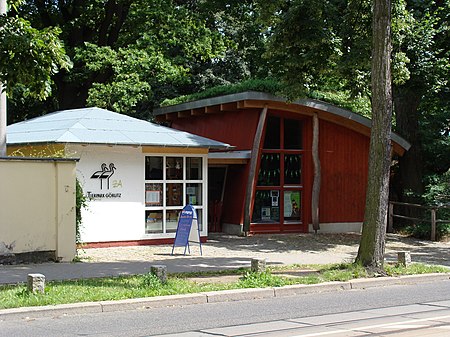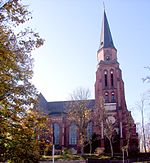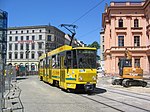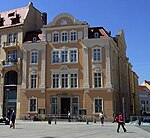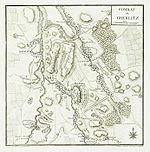Görlitz ([ˈɡœʁlɪts] (listen); Polish: Zgorzelec, Upper Sorbian: Zhorjelc, Silesian: Gorlice, Czech: Zhořelec, East Lusatian dialect: Gerlz, Gerltz, Gerltsch) is a town in the German state of Saxony. It is located on the Lusatian Neisse River, and is the largest town in Upper Lusatia as well as the second-largest town in the region of Lusatia, after Cottbus. Görlitz is the easternmost town in Germany (easternmost village is Zentendorf (Šćeńc)), and lies opposite the Polish town of Zgorzelec, which was the eastern part of Görlitz until 1945. The town has approximately 56,000 inhabitants, which make Görlitz the sixth-largest town in Saxony. It is the seat of the district of Görlitz. Together with Zgorzelec, it forms the Euro City of Görlitz/Zgorzelec, which has a combined population of around 86,000. While not Lusatiophone itself, the town is situated just east of the Sorbian-speaking parts of Lusatia.
The town's recorded history began in the 11th century as a Sorbian settlement. Through its history, it has been under German, Czech (Bohemian), Polish and Hungarian rule, the latter three by invasion. From 1815 until 1918, Görlitz belonged to the Province of Silesia in the Kingdom of Prussia, and later to the Province of Lower Silesia in the Free State of Prussia — it was the Silesian provinces' largest town west of the Oder-Neisse line, and hence Görlitz became part of East Germany from 1949 until German reunification in 1990.
Görlitz is culturally diverse. While it is a town of Saxony, its inhabitants also identify as Upper Lusatian. The East Lusatian dialect (Ostlausitzer Mundart) of the town differs from the Upper Saxon dialects spoken in most parts of Saxony, especially those of Dresden and Leipzig. And because the town had been integrated into the former provinces of Silesia and later Lower Silesia respectively, there is also a strong Silesian element in the city's culture, which is reflected by the presence of some Silesian dishes like Schlesisches Himmelreich or Liegnitzer Bombe, a Silesian Museum (Schlesisches Museum zu Görlitz), or the Silesian Christmas Market (Schlesischer Christkindelmarkt). Additionally, there is the Sorbian element, as Görlitz was founded and first settled by the Sorbs, a Slavic people. This is most obvious in that the name of the town and the etymology of some of its incorporated villages and geographic features are of Slavic origin.
Spared from the destruction of World War II, the town also has a rich architectural heritage. Many movie-makers have used the various sites as filming locations.
